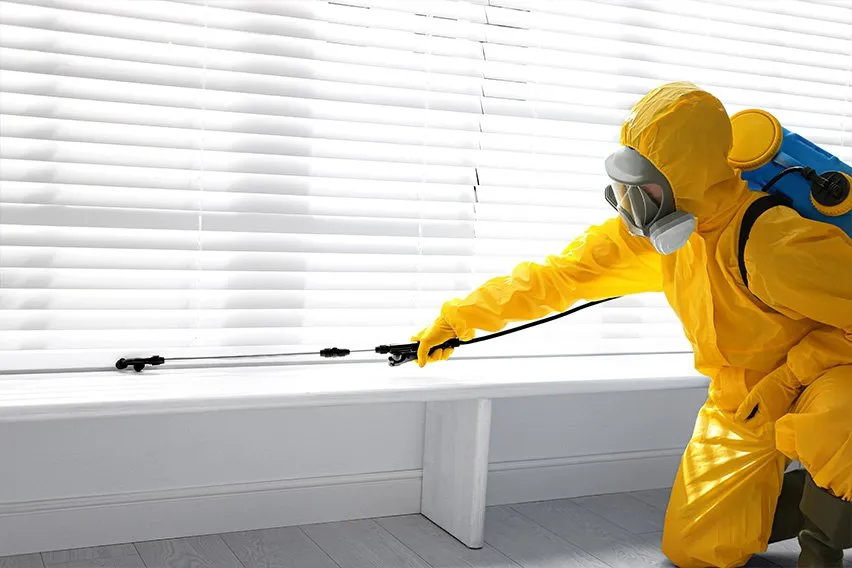How to Start a Pest Control Business

One way to excel in business is by starting a company that addresses a pain point. In the world of pest control, many individuals want to rid their spaces of pests, insects, and other bothersome creatures. If you’re interested in helping people address this common issue, you might be wondering how to start a pest control business.
Even if you don’t have business experience, you can begin the path to entrepreneurship. With a pest control company, you’ll be able to use your knowledge and skills to treat a common problem.
In this user-friendly guide, we’ll introduce the top ten steps you need to follow to start your pest control business today.
Here’s What We’ll Cover:
What Do Pest Control Businesses Do?
10 Steps to Starting a Pest Control Business
Accounting Tips for Your New Pest Control Business
Businesses Related to Pest Control
What Do Pest Control Businesses Do?
A pest control business employs licensed professionals who help property owners remove, manage, or exterminate various types of pests and animals from either inside or outside of their living spaces. Pest control companies implement various methods of extermination and control, which can include chemical sprays, traps, and physical removal.
In most instances, pest control companies strive to teach and equip property owners to maintain pest control for the long-term. This involves regular treatment, check-ins, and upkeep of chemical and organic pesticide applications.

Types of Pest Control Businesses
Starting a pest control company offers numerous options when it comes to which pest control services you provide and what kind of target client you intend to help.
Some of the most popular types of pest control businesses and services include:
- General residential pest control: This type of business primarily reaches homeowners who have basic concerns about infestation within their homes. Common pests include ants, spiders, bees, and mice.
- Commercial pest control: Commercial pest control may be similar to residential services but offers treatment options at a greater scale. This type of business may also focus on safety measures for highly-populated interior and exterior spaces.
- Termite control and removal: Termite removal can be a costly and daunting task. Some pest control companies focus only on this type of pest in order to provide expertise for the removal and treatment of wood termites.
- Fumigation: Fumigation involves filling interior spaces with fumigants in order to suffocate pests with gas. Special care and training are required, since this treatment can affect the physical structure of a building and create potential safety hazards.
Modern pest control services might also set themselves apart by offering organic or eco-friendly options. As concerns around the use of chemical agents and pesticides have grown, more people are searching for safe, environmentally friendly choices. Organic pest control requires different training and products, but it could be very profitable depending on your target market.
10 Steps to Starting a Pest Control Business
Now that you know more about the diversity of pest control companies and how they can address unique customer pain points, it’s time to cover the practical steps. Below are the 10 basic tips you’ll need to start your pest control business with credibility and skill.
1. Narrow Down Your Services
There are a variety of ways that you can provide pest control services and products to your target market. The question is: Which niche will you choose? You’ll need to narrow down your focus in order to become a recognizable expert in one area.
Choosing a pest control niche also helps you carry out essential business tasks. This includes marketing your services, keeping an inventory of necessary products and equipment, and receiving continuing education in your speciality field. Narrowing your offerings also allows you to hire the best candidates for specific jobs.
Lastly, people may be more willing to turn to a specialist when the need arises. If you offer too many broad services, it will be more challenging to fine-tune your skills in a given area.
2. Get the Proper Training
As a pest control provider, you’ll need the proper training for handling chemical treatments and pesticides. Whether you take a certification course, complete an apprenticeship, or attend a trade school, you’ll want to spend some time considering this critical step.
If you already possess a working knowledge of pest control services and standards, make sure to renew any licenses or certifications prior to starting your company. Testing and continuing education rules vary by state, so you’ll want to check with your local jurisdiction for information regarding pesticides and applicator examinations.
3. Build Your Brand
Once you’ve established the foundation, it’s time to customize your brand. You can begin this process by deciding on a professional business name, creating a mission statement, and researching your target audience. This research equips you to develop a brand that stands out from the competition and adheres to your personal values.
What do you want people to see and know when they first interact with your company? Define these answers early to help clarify processes down the line.
4. Get Clear on Your Value Proposition
When comparing pest control services, most customers will want to know what sets your option apart from the pack. As you create your unique value or selling proposition, think about answering these potential questions:
- What unique services do I offer that others don’t?
- What makes my company’s customer service unique and superior to other options?
- How do I solve customer’s pain points in a way that promotes satisfaction?
- What intangible value do customers receive from working with my company?
An example value proposition would be that your company offers a complementary follow-up appointment at no charge after the first on-site pest control visit. This may appeal to customers who are worried about both pricing and results.
5. Apply for the Right Licensing
To operate legally, always follow the regulations of your state, county, or city. This may require you to file the appropriate legal documentation or paperwork and pay administrative fees.
Additionally, don’t neglect setting up your business officially with the IRS. By securing an employer identification number (EIN), you’ll be recognized as an official business. This important step also allows you to claim your business name, open bank accounts, and file business taxes.
6. Set up Your Business Plan
A business plan is an official outline that highlights how you intend to run your new company. A business plan document can include information such as:
- The legal structure of your business (proprietorship, partnership, limited liability company, etc.)
- How you plan to generate revenue
- An overview of available assets and debts
- An official hiring and benefits plan
- Long-range goals and revenue projections
In order to find a small business loan or financing, this document might be required. Prepare in advance by putting together a straightforward plan that highlights some of your biggest goals, challenges, and strengths.
7. Decide on a Pricing Structure
A key consideration in your new business is determining how much you’ll charge for your services. To get an idea of comparable prices, conduct market research in your area.
Many pest control businesses operate with a subscription model, with users paying a monthly or quarterly fee to receive benefits from services. If this is your goal, think about how you’ll handle recurring transactions. Do you need to set up a website for quick and secure payment collection? Creating a simplified user experience increases the odds of getting paid quickly and efficiently after you send an invoice.
8. Purchase Materials and Equipment
Before you open your pest control company, you should have some of the required materials, equipment, supplies, and major purchases. You can fund these investments with personal assets or through small business loan options.
Some of the biggest purchases that you’ll need to make as a pest control business owner are:
- Vehicles or work trucks
- Uniforms, including safety gear and protective equipment
- Chemicals and pesticides
- Equipment for physical removal of pests and application of sprays
- Business-related services like phone, Wi-Fi, and accounting software
9. Hire Employees
Although your pest control service may start small, it’s wise to have a few technicians on staff. By having a team (that can include part-time team members), you’ll be able to reach more customers and accomplish more treatments within a day. Consider your application process, hiring qualifications, and payroll questions prior to hiring.
10. Develop and Implement a Marketing Strategy
Lastly, think about your marketing and advertising tactics. How will new customers find you and know exactly what you offer? Incorporate some of the earlier steps, such as defining your brand and mission, into this part of the process.
To reach more local customers in a short amount of time, you might consider marketing through:
- Local print advertising
- Digital media
- Local and organic search engine optimization (SEO)
- Radio or televised ads
- Word-of-mouth referrals
Successful marketing also includes having greater insight into your target audience or ideal customer. You can accomplish this by researching the common pest control needs in your community, asking for feedback from existing customers, and providing follow-up details about expected results. Each marketing touchpoint is an opportunity to gather relevant data about the unique needs of the customers you serve.

Accounting Tips for Your New Pest Control Business
Maintaining the back end of your business, which includes keeping your books and financial records, might seem daunting. But find the right tools and software, and gaining an accurate picture of your company’s financial standing becomes a breeze. Cloud-based accounting platforms like FreshBooks are ideal for small business owners that need extra support while learning the ropes.
With the right accounting platform, you can better manage the day-to-day business operations that your company relies on. This includes:
- Using invoicing templates to quickly bill customers
- Linking to established business banking accounts
- Incorporating overhead costs into your expense tracking
- Maintaining payroll processes for employees or contractors
- Logging accurate estimates and contract details
Maintaining careful accounting procedures allows for greater accountability when managing business finances. It also relieves many common frustrations, including knowing where your money is going and having the right documentation when it’s time to file taxes.
Keep Your Clients Pest-free Today
Although starting your own company can feel risky, making the leap could unlock a career you love. As you learn how to start a pest control business, you’ll gain an impressive set of professional skills that you can use to build your business and serve those around you.
By choosing to follow a business blueprint, you’ll experience less stress and uncertainty when it comes to major decisions. In your pest control business, always remember to keep an open mind as you explore new tips, strategies, and goals.
With this 10-step framework, you not only have a head start in setting up your pest control service, but you’re also more equipped to find long-term business success.
Businesses Related to Pest Control
RELATED ARTICLES

 How to Start an HVAC Business—9 Step Guide
How to Start an HVAC Business—9 Step Guide How to Become a General Contractor—7 Step Guide
How to Become a General Contractor—7 Step Guide How to Become a Professional Handyman 8 Easy Steps
How to Become a Professional Handyman 8 Easy Steps How to Start a Moving Business in 10 Steps
How to Start a Moving Business in 10 Steps How to Start a Successful Painting Business
How to Start a Successful Painting Business How to Create an Online Portfolio for Photography Studio
How to Create an Online Portfolio for Photography Studio